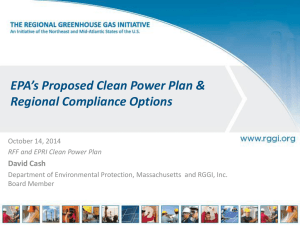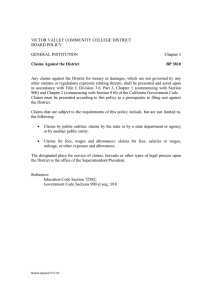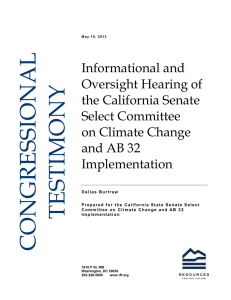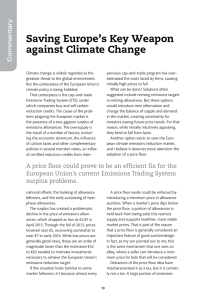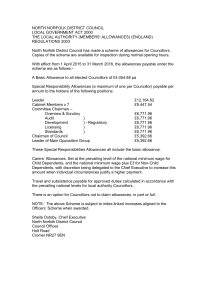Summary of RGGI Model Rule Changes: February 2013
advertisement
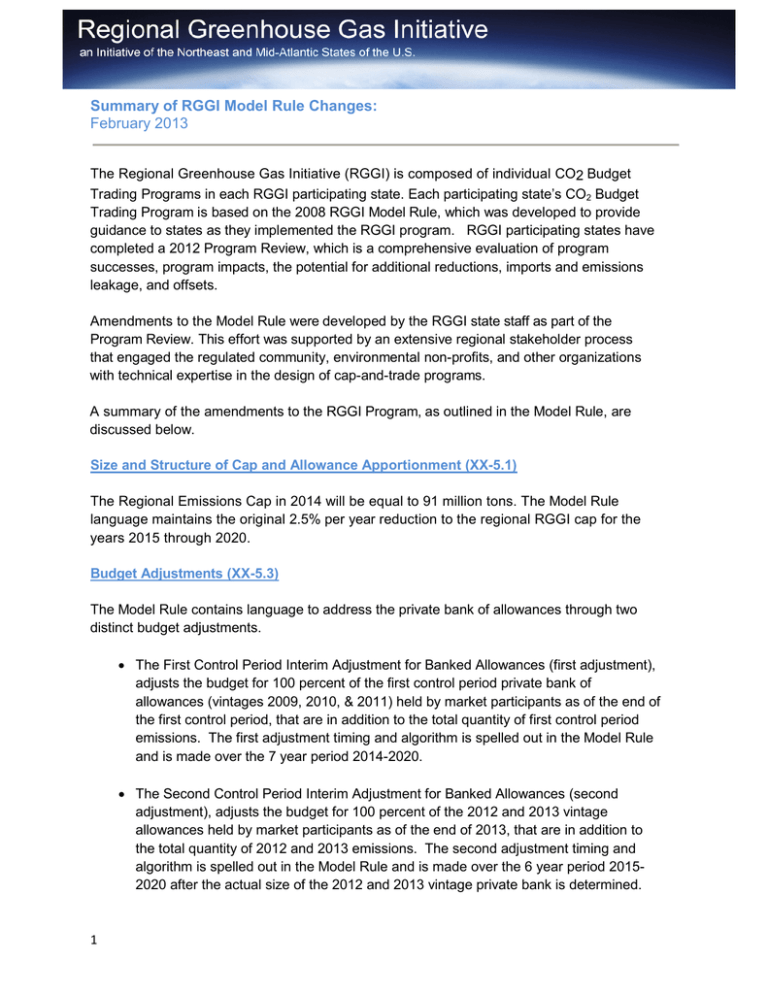
Summary of RGGI Model Rule Changes: February 2013 The Regional Greenhouse Gas Initiative (RGGI) is composed of individual CO2 Budget Trading Programs in each RGGI participating state. Each participating state’s CO2 Budget Trading Program is based on the 2008 RGGI Model Rule, which was developed to provide guidance to states as they implemented the RGGI program. RGGI participating states have completed a 2012 Program Review, which is a comprehensive evaluation of program successes, program impacts, the potential for additional reductions, imports and emissions leakage, and offsets. Amendments to the Model Rule were developed by the RGGI state staff as part of the Program Review. This effort was supported by an extensive regional stakeholder process that engaged the regulated community, environmental non-profits, and other organizations with technical expertise in the design of cap-and-trade programs. A summary of the amendments to the RGGI Program, as outlined in the Model Rule, are discussed below. Size and Structure of Cap and Allowance Apportionment (XX-5.1) The Regional Emissions Cap in 2014 will be equal to 91 million tons. The Model Rule language maintains the original 2.5% per year reduction to the regional RGGI cap for the years 2015 through 2020. Budget Adjustments (XX-5.3) The Model Rule contains language to address the private bank of allowances through two distinct budget adjustments. • The First Control Period Interim Adjustment for Banked Allowances (first adjustment), adjusts the budget for 100 percent of the first control period private bank of allowances (vintages 2009, 2010, & 2011) held by market participants as of the end of the first control period, that are in addition to the total quantity of first control period emissions. The first adjustment timing and algorithm is spelled out in the Model Rule and is made over the 7 year period 2014-2020. • The Second Control Period Interim Adjustment for Banked Allowances (second adjustment), adjusts the budget for 100 percent of the 2012 and 2013 vintage allowances held by market participants as of the end of 2013, that are in addition to the total quantity of 2012 and 2013 emissions. The second adjustment timing and algorithm is spelled out in the Model Rule and is made over the 6 year period 20152020 after the actual size of the 2012 and 2013 vintage private bank is determined. 1 Summary of RGGI Model Rule Changes: February 2013 Interim Control Periods (XX-1.2, XX-1.5, XX-4.1, XX-6.5, and XX-7,2) The Model Rule creates interim control periods that include the following components: • 2 The addition of new defined terms, including: o “Interim Control Period,” defined as each of the first two calendar years of each three-year control period. o “Excess Interim Emissions,” defined as any emissions (multiplied by 0.50) over the amount of allowances held at the end of each Interim Control Period. o A new general requirement for sources to hold allowances to cover 50% of emissions for each Interim Control Period, subject to the existing true-up process and a March 1 deadline. o The final compliance true-up at the end of the three-year control period will continue to require sources to hold allowances to cover 100% of the emissions for the three years. o The allowances already deducted to meet each of the two annual Interim Control Period obligations will be subtracted from the three-year compliance true-up obligation. o Each ton of Excess Interim Emissions will be considered a violation, subject to the ordinary existing enforcement provisions of the relevant agency on an annual basis. o There will not be a “treble damages” provision for Excess Interim Emissions. o The existing “treble damages” provision, for any excess emissions at the end of the three-year control period, will remain unchanged. o The deletion of existing triggers, “market settling period”, and other regulatory terms related to the potential to extend the control period to four years. Summary of RGGI Model Rule Changes: February 2013 Cost Containment Reserve (XX-5.3(c) and XX-9) The Model Rule contains language for the creation and use of a cost containment reserve (CCR) that will provide flexibility and cost containment for the program. The CCR would consist of a fixed quantity of allowances, in addition to the cap, that would be held in reserve, and are only to be made available for sale if allowance prices were to exceed predefined price levels. • • • • • The Model Rule contains language for an annual CCR withdrawal limit of 5 million allowances in 2014, and an annual CCR withdrawal limit of 10 million allowances thereafter. The CCR would initially be populated in 2014, and in subsequent years would be replenished only as needed to maintain the withdrawal limit. Allowances from the CCR would be fully fungible. The CCR allowances would be made available immediately in any auction in which demand for allowances at prices above the CCR trigger price exceeds the supply of allowances offered for sale in that auction prior to the addition of any CCR allowances. If the CCR is triggered, the CCR allowances will only be sold at or above the CCR trigger price. CCR Triggers Prices: $4 in 2014, $6 in 2015, $8 in 2016, and $10 in 2017. Each year after 2017, the CCR trigger price will increase by 2.5%. Offset Trigger Mechanisms (XX-1.2 and XX-10.3) The Model Rule deletes the existing offset price triggers, that raise the allowable percentage of offsets and that allow the use of international CO2 emission credit retirements. The allowable offset percentage would remain at 3.3%, and only those offset credits that satisfy all Model Rule requirements for a specific project category (including any new categories added) may be used for compliance. These changes are consistent with the decision to add a CCR mechanism and address the need for cost control in a much more transparent and predictable way. Control Period Extension (XX-1.2) The Model Rule deletes the potential extension of the control period to four years and is replaced by the CCR. Offsets (XX-10.2 and XX-10.5) 3 Summary of RGGI Model Rule Changes: February 2013 The Model Rule contains language that provides a new offset category known as “Sequestration of carbon due to reforestation, improved forest management or avoided conversion” that States may adopt in lieu of the existing Afforestation category. A RGGI U.S. Forests Offset Protocol has been developed, based mainly on the California Air Resources Board (CARB) U.S. Forests Offset Protocol, to include: • • • Improved Forest Management; Avoided Conversion; and Reforestation (which would replace the existing RGGI Afforestation category type). Wherever possible, the Model Rule intentionally stays consistent with the (CARB) to leverage work done by CARB and the Climate Action Reserve (CAR), because the CARB program is expected to support a domestic supply of these offsets, and to provide consistency. In addition to the Model Rule, States developed a separate U.S. Forests Offset Protocol, as stated above. States may choose to either incorporate the protocol by reference into state regulations, or choose to include the protocol language within state regulations. The RGGI protocol uses a discounting approach, instead of the buffer account approach used by CARB, to address reversals and ensure permanence. Forestry projects that have generated credits in a voluntary offset program would be permitted to transfer to the RGGI program, assuming that they meet all other RGGI requirements and there is no doublecounting. The general additionality requirements of the Model Rule for existing RGGI offset categories have not changed. SF6 Offset Category (XX-10.5(b)) The Model Rule deletes the language referring to consistency applications associated with reductions in emissions of sulfur hexafluoride that were filed prior to 2009 in accordance with Section 10.5(b)(3), as those requirements are no longer applicable. End-Use Energy Efficiency Offsets Category (XX-10.5(d)) The Model Rule deletes language for offset projects commenced prior to January 1, 2009. Incorporation by Reference (XX-10) The Model Rule contains updates for all documents incorporated by reference. 4 Summary of RGGI Model Rule Changes: February 2013 Miscellaneous Reserve Price (XX-1.2) The Model Rule contains language to simplify the reserve price. The Model Rule increases the minimum reserve price by 2.5 percent each year and eliminates the text for current market reserve price. Early Reduction Allowances (XX-5.3) The Model Rule deletes the ERA provisions as they are no longer applicable to the program. Undistributed and Unsold CO2 Allowances (XX-5.2) The Model Rule contains language to provide the ability to retire undistributed and unsold allowances at the end of each control period, subject to each state’s statutory and/or administrative process. 5
